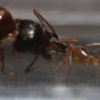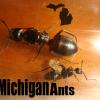PREFACE:
Newbie ant keeper here so still learning so these are just my observations. The type was roughly IDed in the ID forum as potentially T. Curvispinosus, however being so small hard to get a great ID without a microscope.
CATCHING ALATES:
First noted started flying in MA on 6/29 at dusk. Mine were caught around 10pm on a warm humid early Summer night; 66F and 81% humidity; they were only seen during these types of conditions (would go out nightly from 5-6pm and 9pm to 11pm looking for alates all season.) They flew pretty heavily for a few days, but I recall them being seen for about 1 -2 weeks. At their peak, they were easily caught as attracted in high numbers readily to any sort of light; LED or CFL driveway lights and even a LED flashlight set on the ground. I often heard a high pitch flying sound (higher pitched than a mosquito) as the buzzed by my ear, but not 100% attributed to them or something similar fly around the same time. The queen also kept her wings for quite some time (she may even still have at least one now during hibernation, can verify this later), so wing loss is not a good identifier for fertility.
COLONY GROWTH:
I would say a slow colony grower; collected 6/29, about 1 -1.5 weeks later first eggs laid. By end of the summer there were about 4-5 workers before I had an accidental die off from dehydration (more on that in a moment.) Prior to Fall she had laid again one last time, and appeared to be larvae before hibernation.
FOOD:
I did byFormica Sunburst and even chicken scraps from dinner. Mine seemed pretty opportunistic, and not overly picky.
GENERAL OBSERVATIONS:
They are on the tiny end of the ants size spectrum, so don't need a huge space at all. They did not go far to forage at all. At the peak when I had about five workers within a 13mm test tube, and even that felt very large for them. The queen would feed directly within the test tube if food was provided and fairly mobile within the test tube.
You could put them in a cleaned/sterilized acorn (mold always a concern), however not sure if you'd be able to see them well enough or at all. Let me repeat, they are really small, and workers not easy to see as it is. I may try to find a shorter/narrow test tube, with a small opening to the outworld to simulate the tiny opening from an acorn.
One major issue I had was they did NOT go far from then test tube when conditions were poor (original test tube ran dry.) I had connected their 13mm tube to an AMAC box of 4x4". There was a second test tube with fresh water about 1.5" away parallel to the first. Even with them foraging, they never found the 2nd test tube and started to die of dehydration very quickly. For hibernation I attached another tube directly with tape, and seems to be working so far.
They are also pretty relaxed in terms of light levels and their test tube being bumped around. If the cover to test tube was removed, they rarely went into a state of panic for long (if at all) and would continue on as normal as I could tell.
Edited by noebl1, December 22 2016 - 9:18 AM.
![]()
![]()















